McINTOSH BATTERY & OPTICAL CO, CHICAGO, PROFESSIONAL MICROSCOPE, SN-328, C1890

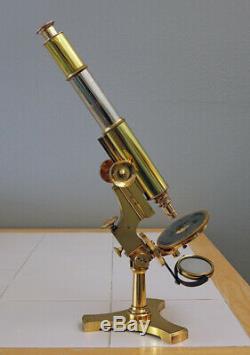


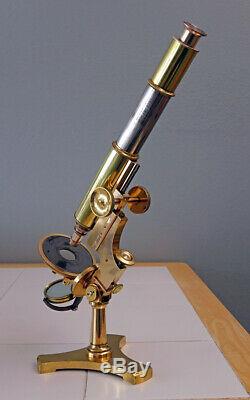

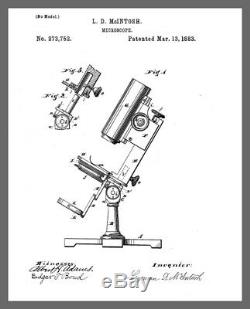
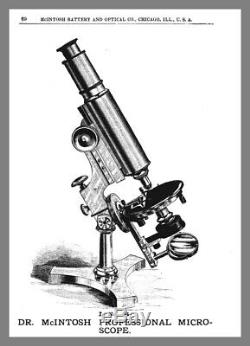
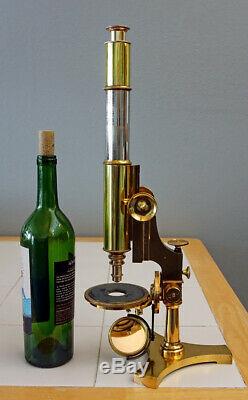
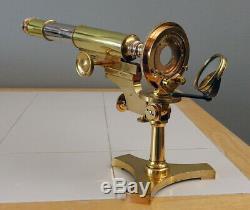
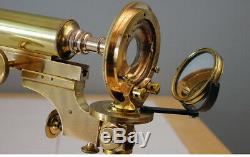


McINTOSH BATTERY & OPTICAL CO. CHICAGO, PROFESSIONAL MICROSCOPE, SN-328, C1890.
CHICAGO, PROFESSIONAL MICROSCOPE, SN-328, CIRCA 1890. This is the largest and most complex model microscope produced by Dr. We have carefully restored this microscope to near to its original condition (see below for details).
This microscope is signed on the top of one of the tripod feet, McIntosh Battery & Optical Co. It also bears a US Patent date, PAT. 13,83along with a serial number, 328.(Note: Please see the accompanying close-up image that shows these inscriptions). The inscribed patent date refers to US Patent Number 273,752 that was granted to L.
McIntosh on March 13, 1883. The object of his patented invention was for specific improvements to the microscope stand and base to enable the microscope to be used either as a solar microscope, a component of a magic lantern projection microscope or a standard monocular microscope without requiring any special skill or labor in making the conversion or any waste of time in so doing. Note: Accompanying this listing is a copy of the patent diagram that illustrates the key features of the patent as granted.
Dating this microscope is somewhat problematic based on the fact that McIntosh did not serialize all of his microscopes and it is unclear if his serialized instruments actually followed a chronological sequence. However, based on the inscribed patent date of 1883, the inscribed serial number of 328 and the name of McIntoshs company as McIntosh Battery & Optical Company (established in 1889), we can conservatively date this microscope to circa 1890.NOTE: For more details on the history of Dr. Also accompanying this listing is a catalogue cut of this same model instrument extracted from my personal copy of McIntoshs 1895 Illustrated Catalogue of Stereopticons, Sciopticons, Dissolving View Apparatus, Microscopes, Solar Microscope and Stereopticon Combinations, etc. The similarities to the listed instrument are readily apparent.
Here is how this Professional model microscope was described in this catalogue. This microscope, in its new and improved form, is the outcome of years of experiment to perfect an instrument adapted to the higher grades of work. The mechanism is perfect, and finely finished; the arrangements for using all necessary accessories are ingenious and convenient, nothing essential being wanting to make it fully equal to all the demands of professional microscope investigation. This microscope is built upon a broad flat heavy lacquered tripod base. Rising from the center of the base is a tapered lacquered brass pillar that terminates in a compass joint.
The joint allows the microscope to be tilted to any angle from the vertical to horizontal. One very unique feature of this microscope is that, in concert with the aforementioned US Patent description, the limb with its attached body tube, stage, etc.
Can be removed from the base by loosening a brass thumb screw found at the back of the limb. Once removed, the working part of the microscope can be used as a solar microscope, or incorporated into a magic lantern apparatus (also known as a stereopticon) for projection of microscopic images for public viewing. Note: Please see the accompanying patent diagram for details on this structural feature along with an accompanying image of the featured microscope showing the working part of the microscope removed from its base. Attached to the compass joint is a nicely sculpted Jackson type limb of lacquered brass. Attached to the leading edge of the lower limb is an L-shaped bracket to which the lower part of the brass stage is mechanically attached with two (2) screws. This arrangement allows for a space between the limb and the rear of the stage support in order to accommodate a swinging substage mirror assembly, which is described in more detail below. This instrument is equipped with a relatively large, 92mm diameter, concentric, rotating stage consisting of a brass frame, in which is set a plate glass disc forming the upper surface of the stage. The center of the stage has a wide 30mm diameter central aperture. There is no provision atop the stage for conventional slide clips. Rather, the top of the stage is set up for a sliding slide carrier, which, incidentally, is missing from this instrument.Filling the space between the leading edge of the lower segment of the limb and the rear of the stage support bracket is a rotating mirror support bar that is mounted on the lower end of a 60mm diameter graduated brass disc. At the end of the mirror support bar is a yoke mounted 50mm diameter plano-concave mirror mounted in lacquered brass. The pivot point for this illumination apparatus is the center of the leading edge of the lower limb at the compass joint so it can rotate around the axis of the stage both below (to provide oblique illumination) and even above the stage to provide incident light to illuminate opaque objects atop the stage (Please see the accompanying composite image that shows the versatility of this arrangement). This appears to be McIntoshs version of the swinging substage mirror assembly that was first invented and Patented by Joseph Zentmayer in the year 1876. Coarse focus is by rack and pinion controlled by a pair of oversized brass milled heads.
The rackwork on this instrument is horizontal rather than angled (see image). Fine focus is by micrometer screw that is found atop the approximate mid-point of the limb.
The top of the fine focus micrometer screw is graduated (see image). The female dovetail that holds the coarse focus rackwork associated with the body tube is free to move along the front face of the limb and is spring loaded within the limb itself.Thus, when the micrometer screw is rotated it acts on a long lever within the limb and the dovetail with the body tube moves slightly up or down providing a rather precise form of fine focus. The lacquered brass body tube of this microscope has a diameter of 1.5 inches and includes a long nickel-plated drawtube with a brass ocular holder at the top.
At the top of the drawtube in the ocular holder is a top-hat style eyepiece that is also unmarked. At the base of the body tube is a single objective lens marked, Gundlach Optical Company, Rochester, N.
Y along with the letter D and 1/5 186 (degrees) for a 1/5-inch power objective (see image). NOTE: McIntosh did not manufacture his own objective lenses. Thus, he customarily supplied objectives with his microscope made by other contemporary opticians including W. When this instrument is set up for observations with the drawtube fully extended, it stands about 19 inches tall making for a relatively large and impressive antique brass microscope.(Note: Please see the accompanying image that compares the height of the microscope with a standard bottle of wine). When the draw tube is fully nested into the body tube and the body tube is racked down to its lowest functional position the instrument stands about 15 inches tall. The microscope weighs about 8 pounds.
There is no wood case or any other accessories that accompany this microscope. NOTE: The accompanying images that were captured under ambient light conditions are a part of this statement of condition. Please take the time to view each of the images so you can confirm the condition of the instrument and so you will know in advance what you will be getting should you prove to be the proud new owner of this very fine and quite rare American made microscope. In summary, as the accompanying images will attest, this McIntosh Professional Microscope is in excellent cosmetic, optical and mechanical condition.This instrument came to us in relatively poor cosmetic and mechanical condition. The microscope had been cleaned and polished in the past by a previous owner and there was a lot of residue from that cleaning medium still evident on the instrument and even in the mechanical parts. The previous cleaning had removed the original lacquer allowing the instrument to tarnish over time. So, we decided to deviate from our customary low-tech treatment of antique brass microscopes by completely restoring the microscope to near to its original condition. This involved breaking the microscope down into its basic components, deep cleaning the instrument using a product called Pre-Lim Metal Burnisher followed by polishing the appropriate major brass parts and carefully re-lacquering the brass parts with a special lacquer formula to prevent future tarnishing.
Then the microscope was reassembled and tested. The mechanical parts were also cleaned and lubed. Because the instrument as it came to us lacked a substage illumination system that was likely lost over the years, we added an appropriate replacement mirror bar, mirror yoke and brass mounted plano-concave mirror from our stock of spare antique microscope parts to make for a completely functional microscope. Note: Please see the accompanying composite image that shows the microscope both before and after restoration.Relative to the optics that accompany the microscope, both the top-hat eyepiece and the Gundlach objective are in excellent optical condition with no internal defects present. The plano side of the replacement mirror is in very good condition.
The concave side of the mirror has some hairline cracks in the silvering, but the glass is in good condition. Both sides of the mirror provide good illumination to the stage.The mechanics associated with this instrument are in very good to excellent condition. Both the coarse and fine focus mechanisms work perfectly and smoothly. The swinging substage mirror system rotates smoothly as designed. The stage rotates freely without binding. However, as noted above, this microscope lacks the sliding slide carrier that would normally come with the instrument.
All in all, this instrument is a nicely preserved and restored example of a McIntosh Battery and Optical Company Professional Microscope and is certain to command a prominent place in any antique microscope collection especially since so relatively few of Dr. McIntoshs microscopes have survived the ravishes to time and circumstances.McIntosh was a physician-surgeon, inventor, electrician and entrepreneur. He received his medical degree from Caledonia Medical College in Caledonia, Vermont in 1863. After graduation, he served as a surgeon in the Union Army during the Civil War. After the war, he practiced medicine in Sheboygan, Wisconsin before moving to Chicago, Illinois in 1872. In addition to his medical practice, McIntosh was particularly fascinated with electricity and produced several electrical devices that we now call quack medical devices designed to improve health or to cure disease.
He also was fascinated with magic lanterns for use in public displays. In addition, he designed, produced and offered several microscope models for sale a total of five different models. Based on information published in his 1895 Illustrated Catalogue of Stereopticons, Sciopticons, Dissolving View Apparatus, Microscopes, Solar Microscope and Stereopticon Combinations, etc , the five (5) microscope models which McIntosh produced consisted of. His Professional Microscope model, which was also designed to be used as a part of a Solar Microscope or heliostat and also in conjunction with his Stereopticon a type of magic lantern. He was granted a US Patent (# 273,752) in March of 1883 for this model that included a feature that enabled it to be easily detached from its tripod base and incorporated into the solar microscope or stereopticon (magic lantern) setups. His New Clinical Microscope No. This was a dual pillar instrument.1 had a manual pull-focus coarse focus mechanism, while the No. 2 had a rack and pinion coarse focus mechanism. This instrument featured a fine focus mechanism located under the limb above the rear of the stage.
1 differed from the No. 2 only by being finished entirely in lacquered brass.
2 included both black Japanned metal and lacquered brass parts. McIntosh produced only a limited number of microscopes during his career, perhaps an estimated total of 600 to 700 units in number.According to Bracegirdle in his Notes On Modern Microscope Manufacturers , serial numbers from 213 to 472 were known when his book was published in 1996. Models found in known private collections and/or are available on the Internet generally seem to fall within this range of serial numbers.
However, another signed McIntosh Scientific Microscope No. Beginning in the year 1872, McIntosh formed several different companies to offer his inventions and wears to the public. In 1882 he formed the McIntosh Galvanic and Faradic Battery Company.
In 1889, he changed the name of the company to McIntosh Battery and Optical Company apparently to more closely reflect the fact that he offered both electrical and optical instruments for sale. His place of business was listed at 521 to 531 Wabash Avenue in Chicago. In 1883, McIntosh exhibited 11 microscopes at the annual meeting of the American Society of Microscopists.In 1890, he exhibited 5 microscopes and other equipment at the American Society of Microscopists meeting in Detroit, MI. McIntosh died in Florida in 1892.
Olmsted Scientific Company, which in turn was bought out by the Chicago Laboratory Supply & Scale Company in 1898. It is highly unlikely that the microscope part of the business that was started by McIntosh survived into the 20th Century. We will also entertain reasonable offers for this very uncommon American made microscope model. FREE scheduling, supersized images and templates.
Make your listings stand out with FREE Vendio custom templates! Over 100,000,000 served.Get FREE counters from Vendio today! The item "McINTOSH BATTERY & OPTICAL CO, CHICAGO, PROFESSIONAL MICROSCOPE, SN-328, C1890" is in sale since Tuesday, January 14, 2020. This item is in the category "Collectibles\Science & Medicine (1930-Now)\Scientific Instruments\Microscopes, Lab Equipment". The seller is "mtloggera" and is located in Hamilton, Montana.
This item can be shipped worldwide.
- Serial Number: 328
- Country of Manufacture: Chicago, Illinois USA
- Country/Region of Manufacture: United States
- Manufacturer: McIntosh Battery & Optical Company
- Product Type: Microscopes, Lab Equipment
- Antique Brass Microscope: Professional Microscope
- Year of Manufacture: Circa 1890

